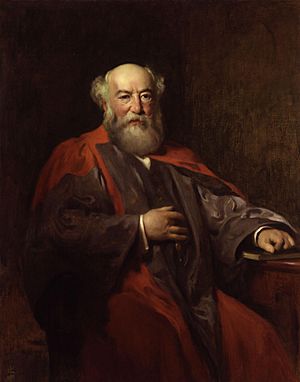Ludwig Mond facts for kids
Quick facts for kids
Ludwig Mond
|
|
|---|---|

Portrait of Ludwig Mond by Solomon Joseph Solomon, circa 1909
|
|
| Born | 7 March 1839 |
| Died | 11 December 1909 (aged 70) Regent's Park, London, England
|
| Nationality | German, British by naturalisation |
| Alma mater | University of Marburg University of Heidelberg |
| Known for | Commercial use of the Solvay process Discovery of nickel carbonyl Mond gas Mond process |
| Spouse(s) | Frida Löwenthal |
| Children | Robert Mond Alfred Mond, 1st Baron Melchett |
| Awards | Grand cordon of the Order of the Crown of Italy Fellow of the Royal Society (1891) |
| Scientific career | |
| Fields | Chemist |
| Institutions | Brunner Mond & Company Mond Nickel Company |
| Doctoral advisor | Hermann Kolbe Robert Bunsen |
Ludwig Mond (born March 7, 1839 – died December 11, 1909) was a very clever chemist and a successful businessman. He was born in Germany but later became a British citizen. He is famous for discovering a new type of chemical compounds called metal carbonyls.
Contents
Ludwig Mond's Early Life and Discoveries
Ludwig Mond was born into a Jewish family in Kassel, Germany. He went to schools in his hometown. Later, he studied chemistry at the University of Marburg and the University of Heidelberg. Even though he never got a degree, he learned a lot from famous professors like Hermann Kolbe and Robert Bunsen.
After his studies, Ludwig worked in factories in Germany and the Netherlands. In 1862, he moved to England. He worked at a factory in Widnes. From 1864 to 1867, he worked in Utrecht, Netherlands. Then he came back to Widnes.
Making Soda Ash Easier
In Widnes, Ludwig worked with a man named John Hutchinson. They found a way to get back sulfur from the waste products of a process called the Leblanc process. This process was used to make soda ash, which is an important chemical.
In 1872, Ludwig learned about a better way to make soda ash. This new method was called the Solvay process. It was being developed by a Belgian businessman named Ernest Solvay.
The next year, Ludwig teamed up with John Brunner. They wanted to make the Solvay process work on a large scale. They started a company called Brunner Mond & Company. They built a factory in Winnington, Northwich. Ludwig solved many problems that made it hard to produce soda ash in large amounts. By 1880, his solutions made the process very successful. Within 20 years, their company became the biggest producer of soda ash in the world!
Discovering Nickel and Helping Workers
Ludwig Mond kept looking for new chemical processes. He discovered a new chemical compound called nickel carbonyl. This was the first time anyone had found a metal carbonyl. He found that this compound could easily be broken down to get pure nickel from its ores. This method is now known as the Mond process.
To use this discovery, he started the Mond Nickel Company. Nickel ores from mines in Canada were partly cleaned there. Then, they were sent to Ludwig's factory in Clydach, Wales, for final cleaning.
Ludwig Mond was also one of the first factory owners to treat his employees very well. He offered them paid holidays and extra benefits.
Awards and Helping Others
Ludwig Mond was a big supporter of science. He helped turn a small local chemistry group into a national organization called the Society of Chemical Industry. He became its president in 1888. In 1891, he was chosen to be a member of the Royal Society, which is a very important science group in Britain.
He also received honors from other countries. He got special awards and honorary doctorates from universities in Italy, Germany, and England.
Ludwig gave money to many scientific groups, including the Royal Society. In his will, he left money to his hometown of Kassel and to several Jewish charities. He also collected many old paintings. He left most of these paintings to the National Gallery, London, so everyone could enjoy them.
Today, the Royal Society of Chemistry gives out the Ludwig Mond Award to honor him. There are also statues of him in Winnington and Clydach.
Ludwig Mond's Family Life
In October 1866, Ludwig Mond married his cousin, Frida Löwenthal. They got married in her hometown of Cologne. Soon after, they moved to England. They had two sons, Robert and Alfred. In 1880, Ludwig became a British citizen.
While he was building his business, his family lived in Winnington. In 1884, they moved to London. In his later years, he often spent winters in Rome, Italy, at his home there. He died in his London home near Regent's Park. He was buried in St. Pancras and Islington Cemetery. His sons built a special monument for him there.
See also
 In Spanish: Ludwig Mond para niños
In Spanish: Ludwig Mond para niños
- Mond gas
- Timeline of hydrogen technologies
- Ludwig Mond Award
- Melchett Medal


